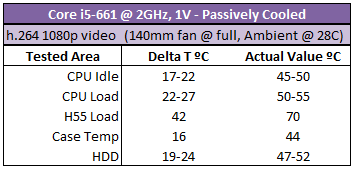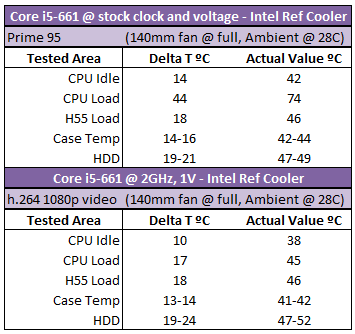
Testing the Array R2
We fitted a Gigabyte GA-H55N-USB3 mini-ITX motherboard, Core i5-661 CPU, 4GB of OCZ 1.35V 1,333MHz DDR3 memory and firstly SilverStone NT06-E CPU cooler then later a reference Intel LGA1156 CPU cooler, along with four Hitachi Ultrastar A7K2000, 2TB hard drives.
Because of the space restriction by the drive cage, we couldn't fit a fan on the SilverStone cooler, instead relying on the PSU fan overhead to generate some airflow. This actually worked, to a degree, but we had to underclock and undervolt the CPU from 3.33GHz to 2GHz, with a vcore of 1V; the IGP (integrated graphics processor) was also undervolted to 1.25V (from 1.35V) and set at 533MHz.
The thinking behind this is the fact as a HTPC or NAS box, you only want just enough performance for your needs, especially if the box is always on. We found that with a passively cooled CPU, the Array R2 kept the processor at around a delta T of 17-22˚C when idle and at a delta T of 50-55˚C when playing a H.264 1080P video. The CPU and GPU were capable of playing this video with no dropped frames.
The H55 chipset was stable but sweaty, with a delta T of 42˚C because there was simply no airflow around the base of the board. We measured the case temperatures separately with a digital thermometer and found it hovered around a delta T of 16˚C.
Despite the only components to get direct airflow, the hard disks themselves measured 47-52˚C in their SMART status (via Crystal Disk Info). While there is evidence that, as long as you don't exceed the maximum operating temperature (typically somewhere around 60-65˚C), temperature does not affect hard drive life, it's still not beneficial to run them within a whiff of their maximum operating temperatures.
With all that in mind, we checked how well the Array R2 would cool things with the retail LGA1156 cooler installed. With a down-blowing fan on the CPU, the H55 chipset temperature should be reduced, as waste airflow would blow over its heatsink.

As expected, there was a significant improvement in the temperature of the H55 chipset, which dropped from a delta T of 42˚C under load to just 18˚C. However, the default frequency and vcore of the CPU saw its delta T temperature rise from 22-27˚C to 44˚C. Surprisingly, the case temperature was slightly lower, even though we reset the CPU to be at its default frequency and vcore. We suspect this is because the CPU cooler and PSU fans were working harder to circulate the air in the case.
At these settings we also saw the maximum hard disk temperature drop by 3˚C. However, setting the CPU back into its underclocked and undervolted state saw the hard disk temperature rise back to the higher temperatures we saw when we used the passive CPU cooler. Clearly the CPU cooler was blowing harder when the CPU was at its default settings, which helped to cool the hard disks.

MSI MPG Velox 100R Chassis Review
October 14 2021 | 15:04








Want to comment? Please log in.